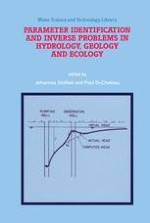1996 | OriginalPaper | Buchkapitel
Gravity Data Inversion Using the Subspace Method
verfasst von : M. Mirzaei, J. W. Bredewout, R. K. Snieder
Erschienen in: Parameter Identification and Inverse Problems in Hydrology, Geology and Ecology
Verlag: Springer Netherlands
Enthalten in: Professional Book Archive
Aktivieren Sie unsere intelligente Suche, um passende Fachinhalte oder Patente zu finden.
Wählen Sie Textabschnitte aus um mit Künstlicher Intelligenz passenden Patente zu finden. powered by
Markieren Sie Textabschnitte, um KI-gestützt weitere passende Inhalte zu finden. powered by
The solution of a nonlinear inverse gravity problem is expanded in terms of orthogonal basis functions and expansion coefficients. The basis functions chosen are the normalized eigenvectors of the second derivatives of the objective function (the Hessian matrix) calculated for an initial model. Of the expansion coefficients obtained in this way a limited number (a subspace) will be used as new model parameters. A new objective function is defined in terms of these new model parameters and is minimized in the subspace of the original ones. The matrix inversion in the subspace of the model parameters will be better conditioned due to less dimensionality and the limited number of eigenvectors used in the inversion. Since the most significant eigenvectors corresponding to the largest eigenvalues are taken in the inversion this will eliminate those elements of the model which are likely to have less influence in fitting the data or lead to local minima. Choosing this strategy makes inversion fast and stable against the noise. The efficiency of the method is tested with synthetic and real gravity data. The tests will prove fast convergence and stability of the inversion against the noise.
